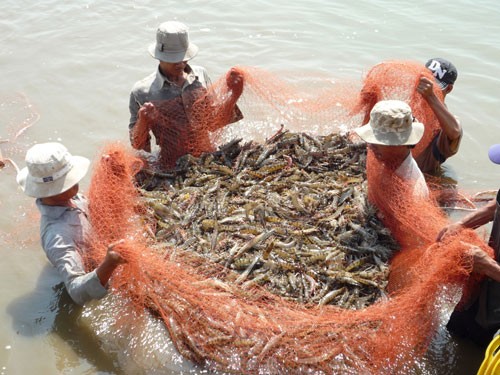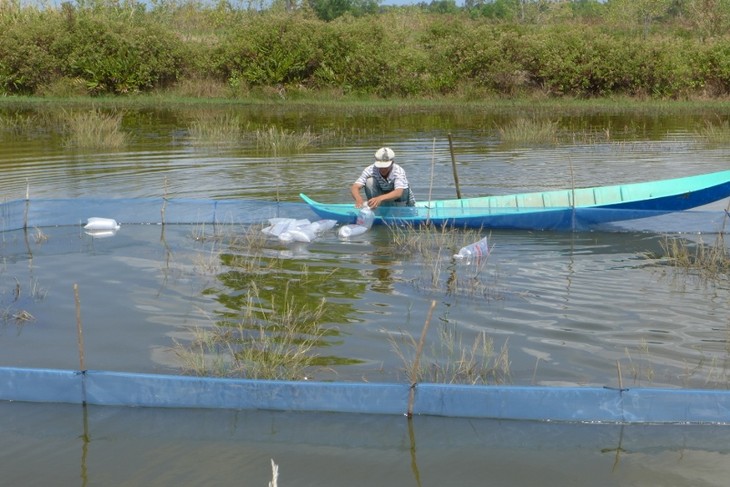(VOVworld) - The Mekong Delta is Vietnam’s largest shrimp farming area, accounting for 94% of the total raising area and 81% of the shrimp production. Currently, the region’s aquaculture is facing difficulties due to the impact of climate change and saline intrusion.
 |
| Farmers raise shrimp (Photo: nongdan24g.com) |
Shrimp are a key Vietnamese seafood product, accounting for half of seafood export revenues. 700,000 hectares are devoted to shrimp cultivation. In 2016 shrimp export turnover is projected to reach 3.2 billion USD and is likely to fetch as much as 8 billion USD by 2025.
Vietnam’s two main types of shrimp are prawn and white-leg shrimp. The Mekong Delta has developed a model to raise red tiger prawns and semisu catus shrimp, which can adapt to saline intrusion.
Dr. Nguyen Van Sang, Director of the Research Institute of Aquaculture No II, said: “The most important things are planning, irrigation, and organizing production for shrimp raising areas. With high saline intrusion, shrimp farming must follow one of two directions. The first is to continue the current model to shrimp-rice farming. The second direction is to expand shrimp cultivation. Some areas which do extensive farming in a reformed way can combine intensive or semi- intensive cultivation. It’s also necessary to improve farming techniques, create food, and control environment and diseases.”
Mekong Delta provinces should promote the application of science and technology in shrimp farming to attain high economic efficiency. The Ministry of Science and Technology will soon unveil a program dedicated to shrimp farming, which can protect the environment while ensuring that products can be traced back to their origin.
Dang Quoc Tuan, Deputy Director General of the Vietnam-Australia Seafood Corporation, one of the largest shrimp spawn producers in Vietnam, said: “The corporation now owns a number of source technologies which, in shrimp the farming value chain, include breeding, food, cultivation, and processing to turn out final products toward ensuring sustainable development for the industry. We are using poly-greenhouses, re-circulating-aquaculture systems, and biofloc technology from Israel. The technology can control the environment in terms of temperature, salinity, alkali rate, and bio-safety.”
A number of marine or freshwater shrimp farming models adapted to climate change and saline intrusion in the Mekong Delta have been deployed and are proving effective.
 |
| Farmers in the Mekong Delta region of Vietnam practice dual rice-shrimp cultivation (Photo: Asian Management and Development Institute) |
The dual rice-shrimp farming model is effective and sustainable due to its simple techniques, low production costs, reduced risks, environmental friendliness, and high product quality. The indoor intensive farming of white leg shrimp, which is widely deployed, has resulted in productivity of up to 40 tons per hectare.
According to Dr. Nhu Van Can, Head of the Aquaculture Department of the Directorate of Fisheries, “The models or technologies used to cope with climate change are environmentally friendly solutions. Two noteworthy solutions are to develop disease-resistant shrimps and high-tech shrimp farming methods.”
Vietnam is one of three countries using an advanced technology in producing feeds for shrimps, which involves using marine organisms as shrimp feed to replace fishmeal. This speeds shrimp growth, lowers production costs, and reduces the risk of shrimp diseases.
In the context of saline intrusion, shrimp farming provinces are stepping up research on shrimp spawn and diversification of shrimp farming models adapted to climate change.